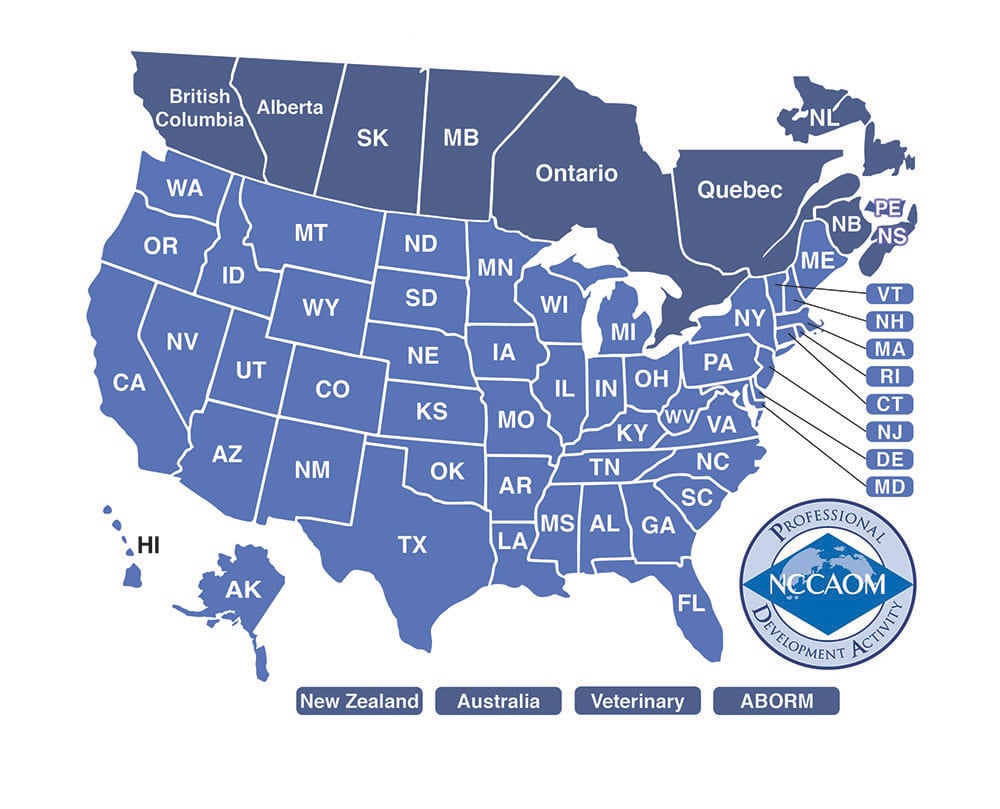Acupuncture Insurance Billing #1
Acupuncture Continuing Education Online Course
Course Samples

This online distance learning course presents basic acupuncture insurance billing procedures. Learn the new ICD-10 diagnosis system to ensure prompt reimbursement. A list of useful diagnosis codes, the 1500 billing form, SOAP notes and other issues regarding insurance billing are reviewed. Learn important questions to ask when calling an insurance company to assure getting correct insurance benefit information. An additional section reviews CPT billing code basics, EOBs (explanations of benefits), superbills and the impact of legislation on billing. Download the course materials, take the online quiz and receive a certificate of completion.
Excerpts:
Sample of Introduction to ICD-10-CM Diagnosis Codes:
New diagnosis codes were originally developed by the World Health Organization (WHO) and are called the International Statistical Classfication of Diseases and Related Health Problems, 10th Revision (ICD-10). The United States has developed a clinical modification of the ICD-10 called the ICD-10-CM (International Statistical Classification of Diseases and Related Health Problems, 10th Revision, Clinical Modification).
Use of ICD-10-CM acupuncture insurance billing diagnosis codes are mandatory beginning October 2015. This system is very different from the old ICD-9 diagnosis codes. The National Center for Health Statistics (HCHS), the Centers for Disease Control (CDC) and the Centers for Medicare & Medicaid Services (CMS) play important roles in developing, maintaining and updating the ICD-10-CM diagnosis codes. Modifications to the codes and related forms over time are part of this process.
The CMS has a downloadable list of all ICD-10-CM billing codes. The CMS file labeled “tabular list” is a downloadable PDF and is the file that contains a quick and easy reference guide to all of the ICD-10 the codes. The link below takes you to ICD-10-CM files but first asks the user to accept the agreement. The PDF file becomes available after accepting the terms. For the complete up-to-date list, visit.... (more in course material)
Sample of ICD-10 related section on Neck Pain and Laterality:
Cervicalgia
Neck pain, cervicalgia, is the first place to start. Most insurance carriers will not reject the use of cervicalgia as a diagnostic specification. The new cervicalgia ICD-10-CM code is M54.2, a simple 4 character alphanumeric code. There is no extra digit ambiguity in this case. Sciatica is another story. The basic ICD-10-CM sciatica code is M54.3. The M54.3 code might be denied because there are five character versions of this code:
M54.30 Sciatica, unspecified side
M54.31 Sciatica, right side
M54.32 Sciatica, left side
Laterality
This is an example of a new feature in the ICD-10-CM system. Laterality may be specified. In this instance, the 5th character designates an unspecific side with a 0, right with a 1 and left with a 2. It is probable that a five character code is going to cause less problems than the four character code. It is less likely to be rejected and sent back for re-billing. In this case, an M54.3 is less likely to be accepted than an M54.30. The greater the specificity, the greater the likelihood of reimbursement. Some carriers may ask for laterality to be specified. In this case, either the right sided M54.31 or left sided M54.32 code will be... (more in course materials)
Sample of ICD-10 section on Headaches and Migraines:
Acupuncturists are often reimbursed for the treatment of headaches. The R51 Headache ICD-10-CM code includes facial pain NOS but excludes atypical face pain (G50.1), migraine and trigeminal neuralgia (G50.0). R51 is only three digits but may be acceptable to many carriers for a headache NOS diagnosis. The migraine code (G43) requires extra character specificity and excludes headache NOS (R51) and lower half migraine (G44.00). The following are a few of the common migraine ICD-10-CM codes:
G43.009 Migraine without aura, not intractable, NOS
G43.109 Migraine with aura, not intractable, NOS
G43.409 Hemiplegic migraine, not intractable, NOS
G43.709 Chronic migraine without aura, not intractable, NOS
G43.909 Migraine NOS
The list for migraines is quite lengthy but a few codes should meet most office needs. The above selection fits the needs of many acupuncture offices. It is expected that most carriers will continue to reimburse for the treatment of headaches and migraines. However, non-pain codes for conditions commonly treated at acupuncture clinics such as G47.00 (insomnia NOS) may... (more in course materials)
Abbreviated sample of ICD-10 section on useful codes (listed):
M54.2 Cervicalgia
M76.50 Patellar tendinitis, unspecified knee
M76.51 Patellar tendinitis, right knee
M76.52 Patellar tendinitis, left knee
M05.33 Rheumatoid arthritis
M16.10 Unilateral primary osteoarthritis, unspecified hip
M54.40 Lumbago with sciatica, unspecified side
M54.41 Lumbago with sciatica, right side
M54.42 Lumbago with sciatica, left side
M54.6 Pain in the thoracic spine
M54.5 Lower Back Pain
M54.30 Sciatica, unspecified side
M54.31 Sciatica, right side
M54.32 Sciatica, left side
M54.9 Dorsalgia, unspecified (backache NOS, back pain NOS)
H57.1 Eye Pain
R10.2 Pelvic and perineal pain
R07.0 Throat pain
K08.8 Tooth pain
F45.42 Pain disorder exclusively related to psychological factors
R51 Headache NOS (...more in course materials)
Abbreviated excerpt of the CPT section:
CPT Basics
Several years ago, there were two acupuncture billing codes. One code was used for electroacupuncture and the other for acupuncture. They have been replaced by four codes.
The 97810 code is for the application of acupuncture. Technically, it is for the application of one or more acupuncture needles during the initial phase of an acupuncture treatment wherein the acupuncturist has “personal one-on-one contact with the patient.” The next code, 97811 is for each additional 15 minutes of acupuncture during that same treatment period. However, the code stipulates that there is a “re-insertion of needles” for it to be allowed.
CPT (Current Procedural Technology) Codes
CPT billing codes for acupuncture procedures are not affected by the change to ICD-10-CM diagnosis codes. CPT® codes are a registered trademark of the AMA (American Medical Association). CPT codes are a number assigned to a procedure and are used in the billing process to determine reimbursement quantities. The CMS writes in their FAQs: ICD-10 Transition Basics publication, “The switch to ICD-10 does not affect CPT coding for outpatient procedures.”
Acupuncture CPT Codes
CPT Code: 97810
Acupuncture, one or more needles, without electrical stimulation, initial 15 minutes.
CPT Code: 97811
Acupuncture, one or more needles, without electrical stimulation, each additional 15 minutes. With re-insertion.
CPT Code: 97813
Acupuncture, one or more needles, with electrical stimulation, initial 15 minutes.
CPT Code: 97814
Acupuncture, one or more needles, with electrical stimulation, each additional 15 minutes. With re-insertion. (more in course materials)
Abbreviated excerpt of the CPT additional code section:
Additional Codes
Acupuncture codes are timed CPT codes. As a result, more than one 97811 or 97814 code can be added to the initial 15 minute timed codes of 97810 and 97814 respectively. For example: 97813, 97814 and another 97814 can be billed if the service is 45 minutes or greater and meets the parameters of the codes. Some carriers limit the amount of codes that may be submitted per visit.
Additional billing codes such as evaluation and management (EM) and physical medicine codes may be added in some cases. Evaluation and management of a patient is built-in to the timed acupuncture CPT codes. However, additional evaluation and management of the patient over and above a reasonable and customary expectation may be billed with an EM code in addition to acupuncture codes. However, SOAP notes must document this additional work. Be prepared for EM codes to be rejected by carriers and sent back with a request for the attachment of SOAP notes to justify the billing.
Another issue encountered by acupuncturists is that some insurance carriers will pay the EM code but not the acupuncture codes when billed together. The acupuncturist must then formally object and re-bill. As a result, many acupuncturists choose to not add EM codes. EM codes are never added on a regular basis and are only for special cases of extended evaluation and management over and above a reasonable expectation.
Physical Medicine Codes
A trouble encountered by licensed acupuncturists is underpayment when adding physiotherapy CPT codes. Legally, acupuncturists are allowed to use these codes but insurance companies may wind up paying for these codes and ignoring the acupuncture codes entirely. These codes include 97110 for therapeutic exercises, 97112 for neuromuscular reeducation, 97114 for functional activities, 97540 for training of activities of daily living, 97610 for soft tissue mobilization, etc….
An example would be the application of tui-na, shiatsu or another form of massage that is billed with the 97610 code, soft tissue mobilization. One would expect that adding additional time for the application of massage would yield a higher reimbursement rate. Unfortunately, some insurance carriers either ignore the physiotherapy code(s) and pay the acupuncture codes or ignore the acupuncture codes and pay the physiotherapy codes.
The carrier may also reduce the patient’s annual allotment of physical therapy appointments by one visit because a physiotherapy code was used. This reduction will appear on the patient’s EOB (Explanation Of Benefits) paperwork that is mailed directly to the patient. This may lead to uncomfortable communication issues wherein the patient may become irate towards the licensed acupuncturist because of the actions of the carrier.
The most important concept here and with all insurance billing is to ensure that a third party, the insurance carrier, does not come between the medical practitioner and the patient.
In some cases insurance carriers will pay for all of the services rendered and billed. Some premium insurance plans continue to... (more in course materials)
Abbreviated excerpt of the health insurance company phone call to get benefit information:
Basic Call Questions
Remember to get the name or ID number of the carrier’s operator and document the date. After getting all of the information, get the call reference number. At the beginning of the call, provide a call-back number to be used in the event of the call being prematurely disconnected.
General Opening Question
Is there acupuncture coverage for licensed acupuncturists?
Deductible
How much is the deductible and how much of it has been met?
Has the deductible been met?
Is there a maximum amount towards each visit applied to the deductible?
Payments
What is the co-pay?
What percentage does the insurance pay?
What is the dollar maximum paid per visit?
Is the reimbursement paid based on the usual, customary and reasonable reimbursement (UCR) determination by the carrier?
What dollar amount is the UCR maximum per visit?
After the UCR amount is met, what percentage is paid on the remainder?
Limits and Exclusions
Is there a limit on the amount reimbursed per year?
Is there a limit on the number of visits per year?
Are there any limits or exclusions on the policy?
Are there any limits on diagnoses? Please let me know what they are.
Are there limits on acupuncture when.... (more in course materials)


